2012/12/01
292. zenbakia

eu es fr en cat gl
Aparecerá un contenido traducido automáticamente. ¿Deseas continuar?
Un contenu traduit automatiquement apparaîtra. Voulez-vous continuer?
An automatically translated content item will be displayed. Do you want to continue?
Apareixerà un contingut traduït automàticament. Vols continuar?
Aparecerá un contido traducido automaticamente. ¿Desexas continuar?
Three spectacular caves of Euskal Herria: Pozalagua, Arrikrutz and Mendukilo
Text created by automatic translator Elia and has not been subsequently revised by translators.
Elia Elhuyar
Because of the characteristics of the underground world, this world remains unknown to most people. The subsoil is said to be a "sixth continent" without investigating. The tourist caves can solve this gap with environmental education scripts and well-documented guides, thus putting this "sixth continent" at the disposal of anyone who wishes. In this way, the entrails of the land are shown in a controlled way, installing a space for the public (like the caves of Pozalagua, Arrikrutz and Mendukilo) and keeping the rest of caves in the shade. These three caves are spectacular, but very different, and today any visitor can enjoy their spectacular. In addition, they allow to know the history of a territory and its inhabitants.
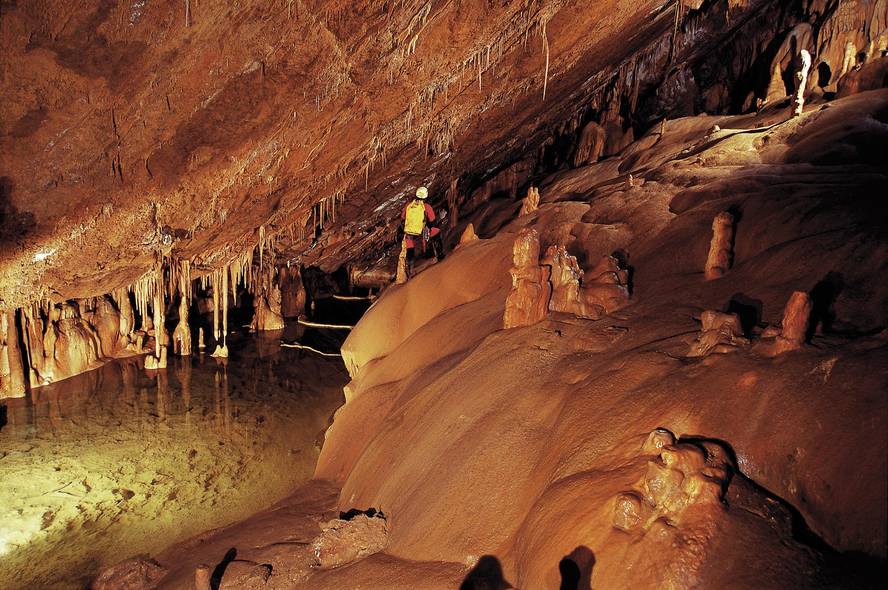
Laminosin room of the cave of Mendukilo. Ed. © Jabier Les
Pozalagua (cave of eccentric stalactites)
Pozalagua is located on Mount Ranero de Carranza (Bizkaia). One of the most spectacular of all Bizkaia: ceilings at a height of twenty or thirty meters, giant columns of calcite, stalactites in search of soil, "gours" or canecillos, visible stone curtains and, in general, the beauty of the cave, are the spectacular of the cave that has lasted many years.
In it, in addition, is one of the most beautiful sets in the world of eccentric stalactites, which extend to all directions instead of directing them towards the ground.
For centuries and during all the silence, water, calcium carbonate and magic have created a winding jungle of eccentric stalactites. Eccentric stalactites, although it is a known phenomenon, are still very little known and always considered exotic and unusual. This cave, even if only for the number of eccentric stalactites it possesses, is worth visiting. Researchers do not know how these mineral deposits were converted, but they know that nature has created these structures for thousands of years. Someone once said looking at the eccentrics of Pozalagua: "This is a winter palace, it seems to be Versailles." Nature has used all its resources to create such a unique treasure in the bowels of the mountain. From then on, the cave houses a room called Versailles.
Pozalagua is part of the Natural Park of Armañón. It includes extensive autochthonous forests such as oak, oak and beech forests, as well as mixed hardwood forests in valleys and hillsides. Therefore, visitors can also perform nice routes around.
Mendukilo (cave of the lakes)
The cave of Mendukilo is located in the valley of Larraun (Navarre), in communal lands of the Council of Astitz, in the foothills of the mountain of Aralar at 750 m of height. Its use by the shepherds is very old, since it is suitable for use as a mountain refuge, due to two characteristics: the entrance mouth, facing north, and the first spacious room, accessible and well lit by natural light. The name of the cave has its origin in it, that is, it was the stable of Mount Mendukilo. The small archaeological site found in the entrance hall (Artzainzulo) shows that the shepherds of the area during the Iron Age (800-300 BC) They also used it. It is currently adapted to welcome tourists and schoolchildren. It has outdoor parking, host house and a small botanical tour.
The aim of the cave is to show the wonders of the subsoil so that the visitor becomes aware of the importance of caring for and protecting these things. The habilitation of the cave has had a double objective: to prime the cave and minimize the impact. To respond to the first objective, two of the six rooms of the cave have not been conditioned for the public, since the accesses to these rooms are very narrow and so that visitors can access it is necessary to drill much. In addition, the fauna and quality of the cave abandoned in the existing ones has been respected. On the other hand, to minimize the impact of the habilitation, removable infrastructures have been installed and currently you can visit the halls Artzainzulo, Laminosin and Herensuge.
Throughout the year, guided tours are carried out and the script is based on the principles of environmental education. In addition, throughout the school year, programs aimed at schoolchildren based on environmental education are carried out. The aim of these programs is to awaken sensitivity and awareness, since knowledge is the basis of respect. The teaching units are adapted to the school curriculum of each course and aim to be a practical component of the work in the theoretical classes.
As for the exterior, the abundance of megalithic monuments (the first, built more than 4,000 years ago) throughout the mountain range, indicates that it has been present since the pasture prehistory. The pastures that demand the cattle and the way of life of the shepherds, that is, the human influence, have shaped to a large extent the current aspect of the mountains, whose ecosystem is the result of long years of coexistence between the grazing and the wildlife. Without forests we can see perfectly some of the outer formations of karst: dolinas, lapiaces, cliffs...
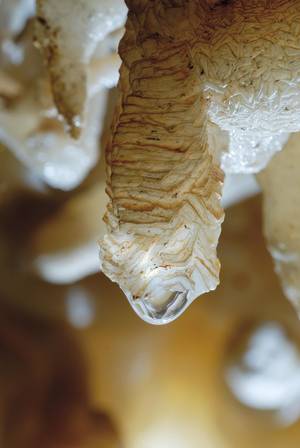
Special rock stalactite from Pozalagua. Ed. © Jabier Les
The Mendukilo Project has gone from being a mountain stable to being an ecotourism equipment, an underground laboratory and an environmental education room. Following the philosophy of the first shepherds who used the cave, a responsible training focused on management oriented towards ecotourism is proposed.
Its objective is to recover and maintain the natural space in which ecotourism is developed. That is, it aims to be a useful tool for the recovery of natural space, which ensures the enjoyment of the coming generations, since the only natural space profitable is that which lasts from generation to generation. In this way, in addition to developing in a natural space, it must be developed both by the environment and by the environment. Economic benefits will result in the benefit of the local population. But it also offers visitors the possibility of enjoying a healthy leisure and expanding knowledge about nature.
In this sense, ecotourism and well-oriented and planned rural tourism can be a balanced development of the valley and its surroundings. With the aim of capturing and promoting tourism resources in the area, the Plazaola Tourism Consortium was established in 1994. For this reason, the following complementary actions have been launched:
- Plazaola passport. The proposal promoted by the Tourism Consortium has involved numerous rural houses, restaurants, activity companies and tourism resources. In this initiative, a sealed passport generates different discounts in participating establishments.
- Subsoil Without Borders. 6 tourist caves twinned (Mendukilo, Arrikrutz, Pozalagua, Ikaburu, Sara and Zugarramurdi) to facilitate access to the underground world visitor and reward the visit. In this initiative, a promotional brochure has been created with all the information about each of the twinned caves. This brochure is sealed when you visit a cave and entitles you to a discount of the individual rate when you visit another cave. With all the sealed brochure is collected a gift in the last cave visited.
Arrikrutz-Oñati caves (mythology and legends)
Inside Gipuzkoa, the landscape of Oñati has interesting elements of great quality. On the slopes of Mount Aizkorri, near the Sanctuary of Arantzazu, there are spectacular limestones, and on the underground, along 14 kilometers that houses the complex and spectacular karst systems of Salinas de Arrikrutz, phenomena and complex speleological spaces like the cavity of the cave of Arrikrutz.
The underground streams and galleries filled with enormous stalactites are a sign of their geological composition and richness.
The tourism project aims to increase the value of natural and cultural heritage. Arrikrutz is one of the pioneers of Euskadi in speleological, archaeological and paleontological studies. In the first works archaeological remains were discovered as the complete skeleton of a rock lion, first discovery of this type in the State. In addition, it has skeletal remains and skulls of panthers and a spectacular deposit of bears.
As for mythology, it should be noted that hundreds of years ago the inhabitants of Oñati, Alto Deba and Alava went to the cave of Sandaili on pilgrimage to ask for rain for the solos. On the other hand, sterile women bathed in the waters of Sandaili to be fertile. In this way the customs created thousands of years before -- at the time of the Gentiles were maintained. Taking into account all these considerations, the Council of Oñati, unanimously decided to improve and complete its natural offer, preparing the cave of Oñati-Arrikrutz for the reception of visitors.
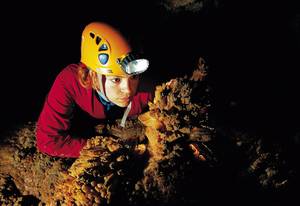
In the cave of Pozalagua, studying some special stalagmites of aragonite. Ed. © Jabier Les
The system of travel through the interior of the cave allows to approach from a pedagogical point of view and in a totally interesting way topics such as the chiseling of the cave by water and hydrology, the creation of the mineral universe, the archaeological and paleontological findings of Arrikrutz, the Sandailian mythology or the importance of Arrikrutz in the history of speleology.
Linguistic advisor: Agurtzane Urrutia.
Offer on offer Offer
Iñaki
You go away, you come, and you leave rings in my imagination (G. Belli)
Asierri
Justice is like snakes, they only bite barefoot (E. Galeano)
Asier died on December 1, 2008, in a work accident that occurred in the Southern Variant of Bilbao (Supersur), due to the failure to comply with safety measures at work, as resolved on Bilbao's 9th. Judgment nº 131 of 18 March 2011 of the Social Tribunal. However, we were annulled by the criminal procedure. (asierirazabal.wordpress.com).
Bibliography Bibliography Bibliography
Bridge B.: "Pozalagua, underground laboratory", in Elhuyar, 233 (2007), 18-22.
Euryale Nº 1. Review of speleological studies. (2006) BI-1502-06 ISSN: 1886-4309. Studies of the Association of Speleological Sciences Alfonso Antxia. Bilbao.
Euryale nº 2. Review of speleological studies. (2009) BI-1502-06 ISSN: 1886-4309. Studies of the Association of Speleological Sciences Alfonso Antxia. Bilbao.
www.sociedadalfonsoantxia.org.
Pozalagua, Arrikrutz and Mendukilo: underground laboratories
The researchers wanted to know the creation and evolution of these caves, analyze the current situation and find a way of protection for the future through measures that allow to combine the protection of the environment with the visitors' visits, since, at least, the first hypotheses indicate that there is nothing that can disappear as a result of the visits. But to do this we must support them, and several departments of the University of the Basque Country and other universities, together with Alfonso Antxia, Association of Speleological Sciences, launched an interdisciplinary investigation. Pozalagua, Mendukilo and Arrikrutz are some of the most important underground laboratories in the world.
In the underground laboratories are carried out climate studies (every hour and hour, among others, temperature of rock and air, humidity, atmospheric pressure, concentration of carbon dioxide), hydrochemical and microbiological analysis of water, study of fauna (vertebrates and invertebrates) and microflora, as well as measurements of natural radioactivity, air currents and intake of drip water. In addition, geotechnical studies are carried out annually.
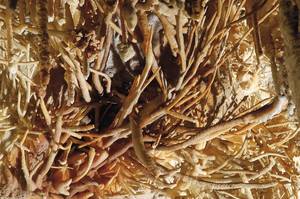
Eccentric stalactites of Pozalagua. Ed. © Jabier Les
To ensure the sustainability of visits, indoor (and outdoor) climate stations are established in the visitable rooms. The comparison between the results obtained in the stations and the number of visits made allows to determine the load capacity of the caves. Once the climate studies have been completed (data collection of at least 5 years), the results have been integrated into management.
Multidisciplinary research has been carried out in caves. No short-term results are expected, but researchers expect that the knowledge collected in these underground laboratories will serve in the medium term to complete a method of cave management. In addition, members of Alfonso Antxia are designing a computer model for predicting climatic variables in tourist caves.
Diseases of the tourist caves
The body mass of people transfers to the environment a certain amount of calories, thus facilitating the increase of the local temperature. If the caves are visited by large groups of people, this fact is much more evident.
In addition to the aforementioned thermal load, due to the process of perspiration, visitors also eject a quantity of water vapor, either by surface or by means of the spiral air. This causes an increase in water vapor in the atmosphere that could increase supersaturation and condensation.
One of the most important factors when analyzing the influence of visitors in the cave is carbon dioxide, CO 2. It especially affects secondary formations, causing decalcification and destruction. In Pozalaga, above all, we must continue with great care.
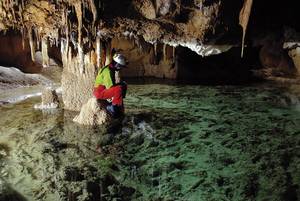
Lake Laminosin in the cave of Mendukilo. Ed. © Jabier Les
If you want to keep the cave beautiful and attractive, and avoid further deterioration, you need to limit the number of visits and comply with certain rules properly. These rules do not apply in any case, for which it is necessary to carry out an exhaustive microclimate study of the cave and to know the mechanisms that allow the energy and mass exchange between solid, liquid and gaseous systems and between external and internal systems. For example, in Pozalagua it was proposed to reduce to 80 people the number of people who can access the interior of the cave, to 50 in Mendukilo and to 25 in Arrikrutz. And in Mendukilo and Arrikrutz a maximum duration of 60 minutes was proposed and in Pozalaga 45 minutes.
Bad green green bad
Visits to Pozalagua began two decades ago. In order for visitors to see the cave, an interior lighting was installed that caused a green condition. That is, the plants began to colonize the cave, finding inside moss, lichens and ferns. The Department of Plant Biology and Ecology of the UPV/EHU assumed the cataloging of the vegetation of Pozalagua. In addition to the cataloging of the vegetation, they analyzed what were the most suitable conditions for its cultivation. Plants only use the heat of light and part of the radiation. If the conditions necessary for the growth of the plants are known, modifying these conditions (for example, by placing long wave light) it may be possible to continue with the visits and avoid the growth of the vegetation. The illumination to avoid the green condition should be monitored carefully along the route and use colder lights. Therefore, the work of the researchers is not only to make proposals to eliminate the cataloging and green lacra, but also to modify the conditions that make possible the proliferation of plants. At present, Pozalagua and Mendukilo have cold lights and only the place where the group of visits is located, that is, the lighting and the group of visits are synchronized.
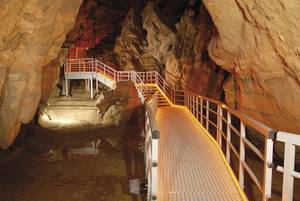
Detachable steps in the cave of Arrikrutz. Ed. © Jabier Les
The chemicals in the research team were also of great help to help clear green disease. They invented a species of plaster to remove the vegetation without damaging the speleotopics. The plate tests based on ion exchange gave excellent results. He was also responsible for knowing the exact composition of the speleotopics.
The affected can't recover, but researchers always want to find a way to prevent damage from getting worse. For this reason, multidisciplinary research was launched.
Biological biological biological
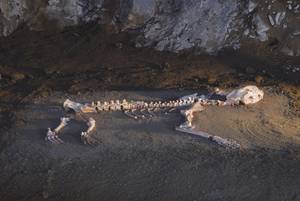
Bones of a cave lion discovered in the cave of Arrikrutz. Ed. © Jabier Les
The living creatures of the caves have been taken into account and the beings found in the caves have been analyzed and described before carrying out the towing work. In addition to the bats, one of the beings in the cave of Mendukilo is the troglob, an arthropod adapted to the conditions of the cave and that lives only in rooms not open to the public. In Pozalagua also inhabit some arthropods, among which is a colémbolo described for the first time in this cave.
Arrangement with prudence
In Mendukilo, among other things, they have taken great care not to damage the underground treasures. Geotechnical studies were also carried out before the conditioning of the cave of Mendukilo, the most important to evaluate the stability of the ceilings, walls and rooms that would be used in the tourist itinerary. As a result, in the first room the downstream ramp has been filled, with gravel or sand and to be conditioned with the causeway, limiting it by a concrete strip (so that it does not move). This arrangement allows the filtration of the water by its original route and the growth of the correspondences of the lower rooms. Habilitation of the interior rooms by floating, metallic, galvanized and removable steps. The entrance grate, designed by a bat specialist, is permeable for all species that live in the area. It has horizontal bars to leave the step, avoiding the forced maneuvers by the vertical bars during the flights.












